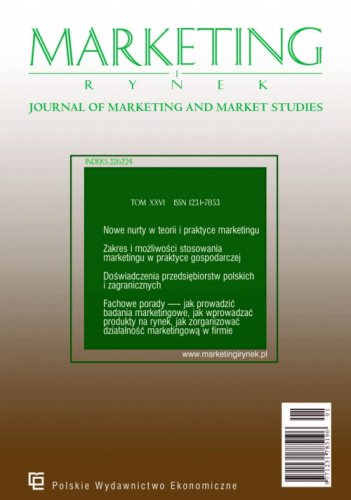Zmiany w zachowaniach konsumenckich osób starszych w trakcie pandemii COVID-19 w świetle analizy trendów konsumenckich
Pandemia COVID-19 zmieniła zachowania konsumenckie wszystkich konsumentów, także konsumentów seniorów. Artykuł przedstawia zmiany w trendach konsumenckich w grupie starszych konsumentów. Jego głównym celem jest próba odpowiedzi na pytania: czy w porównaniu do czasu przed pandemią nastąpiły zmiany w zachowaniach konsumenckich seniorów, czy pojawiły się zachowania charakterystyczne dla tej grupy oraz które z nich wyraźnie dominują? Do analizy wykorzystano literaturę przedmiotu i raporty Euromonitor International za lata 2017–2022. Na podstawie zaobserwowanych trendów opisano sylwetkę seniora jako konsumenta świadomego swoich wyborów, o wysokim poziomie wiedzy technologicznej, a jednocześnie skupionego na swoich potrzebach i dbającego o zdrowie.
Bibliografia
Bibliografia/References
Accenture (2020a). COVID-19: How is the Retail Consumer Changing? Pobrane z: https://www.accenture.com/_acnmedia/PDF-130/Accenture-Retail-Research-POV-Wave-Seven.pdf (17.05.2022).
Accenture. (2020b). How COVID-19 will permanently change consumer behavior. Pobrane z: https://www.accenture.com/_acnmedia/PDF-134/Accenture-COVID19-Consumer-Behaviour-Survey-Research-PoV.pdf (17.05.2022).
Aldridge, A. (2006). Konsumpcja. Sic!
Angus, A. (Red.). (2018). Top 10 Global Consumer Trends for 2018 Emerging Forces Shaping Consumer Behaviour. Euromonitor International.
Angus, A., & Westbrook, G. (Red.). (2019). Top 10 Global Consumer Trends 2019. Euromonitor International.
Angus, A., & Westbrook, G. (Red.). (2020). Top 10 Global Consumer Trends 2020. Euromonitor International.
Angus, A., & Westbrook, G. (Red.). (2021). Top 10 Global Consumer Trends 2021. Euromonitor International.
Angus, A., & Westbrook, G. (Red.). (2022). Top 10 Global Consumer Trends 2022. Euromonitor International.
Bytyçi, S., Shala, V., Ziberi, B., & Myftaraj, E. (2021). Transforming traditional business into online: the impact of Covid-19 pandemic on consumer behavior. Journal of Governance and Regulation, 10(2). https://doi.org/10.22495/jgrv10i2siart10
Bywalec, C. (2017). Gospodarstwo domowe. Ekonomika, finanse, konsumpcja. Wydawnictwo Uniwersytetu Ekonomicznego w Krakowie.
Długofalowa Polityka Senioralna w Polsce na lata 2014–2020. Pobrane z: www.senior.gov.pl/materialy_i_badania/pokaz/7 (17.05.2022).
Hatalska, N. (2022). Mapa trendów. Pobrane z: https://hatalska.com/2022/02/10/mapa-trendow-2022/ (24.09.2022).
Hesham, F., Riadh, H., & Sihem, N. K. (2021). What Have We Learned about the Effects of the COVID-19 Pandemic on Consumer Behavior? Sustainability, (13). https://doi.org/10.3390/su13084304
Kasriel-Alexander, D. (2017). Top 10 Global Consumer Tends for 2017. Euromonitor International.
Kucner, A., Sierocki, R., & Wasyluk, A. (Red.). (2018). Trendy. Interpretacje i konfrontacje. Uniwersytet Warmińsko-Mazurski w Olsztynie.
Mooij, de M. (2019). Consumer behavior and culture: Consequences for global marketing and advertising. Sage.
Moon, J., Choe, Y., & Song, H. (2021). Determinants of Consumers' Online/Offline Shopping Behaviours during the COVID-19 Pandemic. Int J Environ Res Public Health, 18(4). https://doi.org/10.3390/ijerph18041593
Moore, S. (2021). History of COVID-19. Pobrane z: https://www.news-medical.net/health/History-of-COVID-19.aspx (15.05.2022).
Morgan, J. P. (2020). How COVID-19 has transformed consumer spending habits. Pobrane z: https://www.jpmorgan.com/solutions/cib/research/covid-spending-habits (17.05.2022)
Naisbitt, J. (1982). Ten New Directions Transforming Our Lives. Warner Books.
Oszust, K., & Stecko, J. (2020). Theoretical aspects of consumer behaviour together with an analysis of trends in modern consumer behaviour. Modern Management Review, 25(4). https://doi.org/10.7862/rz.2020.mmr.32
Ozili, P., & Arun, T. (2020). Spillover of COVID-19: impact on the Global Economy. Global Spillover. https://doi.org/10.2139/ssrn.3562570
Petcharat, T., & Leelasantitham, A. (2021). A retentive consumer behavior assessment model of the online purchase decision-making process. Heliyon, 7(10). https://doi.org/10.1016/j.heliyon.2021.e08169
Raymond, M. (2010). The Trend Forecaster's Handbook. Laurence King Publishing.
Rokicki, A. (2016). Starość nie znaczy bierność — współczesne metody aktywizowania seniorów. ANNALES UMCS Lublin-Polonia, XXIX(1).
Rudnik, A. (2016). Wymiary starości i cechy ludzi starych w percepcji dzieci i młodzieży. Pogranicze. Studia Społeczne, XXVIII. https://doi.org/10.15290/pss.2016.28.11
Samli, A .C. (2012). International Consumer Behavior in the 21st Century: Impact on Marketing Strategy Development. Springer Science & Business Media.
Smyczek, S., & Sowa, I. (2005). Konsument na rynku. Zachowania, modele, aplikacje. Difin.
Svajdova, L. (2021). Consumer Behaviour during Pandemic of COVID-19. Journal of International Business Research and Marketing, 6(3). https://doi.org/10.18775/jibrm.1849-8558.2015.63.3005
Szmigin, I., & Piacentini, M. (2018). Consumer behaviour. Oxford University Press.
Tkaczyk, J. (2012). Trendy konsumenckie i ich implikacje marketingowe. Handel Wewnętrzny, (5–6).
Ustawa z 11 września 2015 r. o osobach starszych, Dz.U. 2015 poz. 1705.
Vejlgaard, H. (2012). Anatomia megatrendu. Co łączy jeansy z łyżworolkami i iPodem. Oficyna a Wolters Kluwer business.
Włodarczyk, K. (2013). Rynkowe zachowania polskich konsumentów w dobie globalizacji konsumpcji. Wydawnictwo Adam Marszałek.
World Health Organization (WHO). (2020a). Pobrane z: https://www.who.int/emergencies/diseases/novel-coronavirus-2019/events-as-they-happen (15.05.2022).
World Health Organization (WHO). (2020b). Pobrane z: https://www.who.int/emergencies/diseases/novel-coronavirus-2019/advice-for-public (15.05.2022).
World Health Organization (WHO). Pobrane z: https://www.who.int/ (17.05.2022).
Zalega, T. (2012). Konsumpcja. Determinanty, teorie, modele. PWE.
Zalega, T. (2013). Nowe trendy i makrotrendy w zachowaniach konsumenckich gospodarstw domowych w XXI wieku. Konsumpcja i Rozwój, (2).

